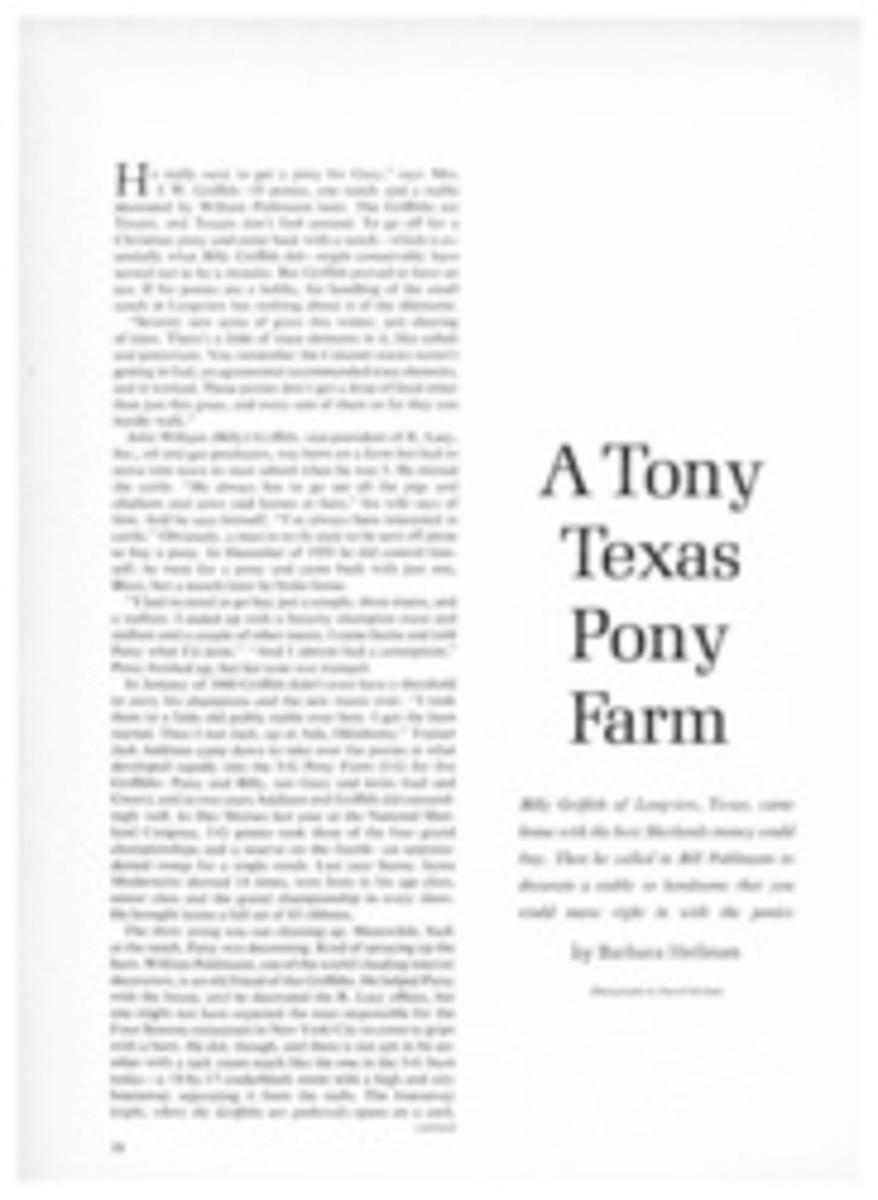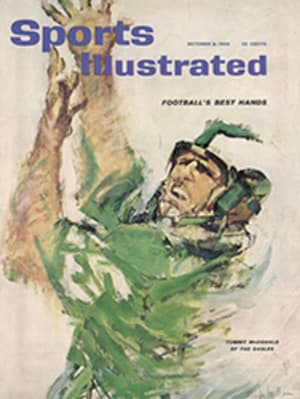
A Tony Texas Pony Farm
He really went to get a pony for Gary," says Mrs. J. W. Griffith—85 ponies, one ranch and a stable decorated by William Pahlmann later. The Griffiths are Texans, and Texans don't fool around. To go off for a Christmas pony and come back with a ranch—which is essentially what Billy Griffith did—might conceivably have turned out to be a mistake. But Griffith proved to have an eye. If his ponies are a hobby, his handling of the small ranch in Longview has nothing about it of the dilettante.
"Seventy new acres of grass this winter, just clearing of trees. There's a little of trace elements in it, like cobalt and potassium. You remember the Calumet mares weren't getting in foal; an agronomist recommended trace elements, and it worked. These ponies don't get a drop of food other than just this grass, and every one of them so fat they can hardly walk."
John William (Billy) Griffith, vice-president of R. Lacy, Inc., oil and gas producers, was born on a farm but had to move into town to start school when he was 5. He missed the cattle. "He always has to go see all the pigs and chickens and cows and horses at fairs," his wife says of him. And he says himself, "I've always been interested in cattle." Obviously, a man in no fit state to be sent off alone to buy a pony. In December of 1959 he did control himself; he went for a pony and came back with just one, Blaze, but a month later he broke loose.
"I had in mind to go buy just a couple, three mares, and a stallion. I ended up with a futurity champion mare and stallion and a couple of other mares. I came home and told Patsy what I'd done." "And I almost had a conniption," Patsy finished up, but her tone was tranquil.
In January of 1960 Griffith didn't even have a threshold to carry his champions and the new mares over. "I took them to a little old public stable over here. I got the barn started. Then I met Jack, up at Ada, Oklahoma." Trainer Jack Addison came down to take over the ponies at what developed rapidly into the 5-G Pony Farm (5-G for five Griffiths: Patsy and Billy, son Gary and twins Gail and Gwen), and in two years Addison and Griffith did astoundingly well. In Des Moines last year at the National Shetland Congress, 5-G ponies took three of the four grand championships and a reserve on the fourth—an unprecedented sweep for a single ranch. Last year Sunny Acres Modernaire showed 14 times, won firsts in his age class, senior class and the grand championship in every show. He brought home a full set of 43 ribbons.
The show string was out cleaning up. Meanwhile, back at the ranch, Patsy was decorating. Kind of sprucing up the barn. William Pahlmann, one of the world's leading interior decorators, is an old friend of the Griffiths. He helped Patsy with the house, and he decorated the R. Lacy offices, but one might not have expected the man responsible for the Four Seasons restaurant in New York City to come to grips with a barn. He did, though, and there is not apt to be another with a tack room much like the one in the 5-G barn today—a 19-by-17 cinderblock room with a high and airy breezeway separating it from the stalls. The breezeway (right, where the Griffiths are gathered) opens on a cool, deep porch and is filled with plants—hanging plants and potted plants, beneath a skylight. It has somewhat the air of the interior gardens of New Orleans courtyards. The oak refectory table, the stools, the great ships' wheels, high at either end above the doors, and the iron wall brackets allare English antiques. On a marble shelf there is an American pacing-horse weathervane. The side chairs are 17th century Spanish. The walls themselves are whimsical with antique wooden and metal signs.
In the tack room there are also wall brackets on the sage-green block walls, and Gothic corner chairs flank an early 18th century English sideboard. An old Spanish chest studded with nailheads, a Portuguese chest of drawers, a Franklin stove and a metal "African dinner pail, I think," as Billy describes it, sit companionably cheek by jowl. There are English powder horns, papier-m√¢aché horses, framed antique pony seals. There are an ivory-headed cane containing a horse-measuring stick marked in inches and hands, pewter plates, fat Mexican pottery birds, a balsa-wood decoy, a leather fire bucket. The antiques represent their various countries and centuries with a comfortable grace and no decorative discord.
"Bill Pahlmann can get by with putting more things together than I believe any other person could," Patsy says.
The breezeway and the porch overlook a 16-acre pond Billy Griffith put there. It is stocked with bream, bass and channel cats, which have already reached a good size, and on it float small green wooden structures exactly, from a distance, like the green wood Monopoly houses of the days before plastic set in. "Duck apartments," Billy says. "The dogs were bothering the nests along the banks, so I made these and floated them on inner tubes. Each one has four rooms, and they're all full of mallards."
Billy's little ranch is as big as he cares to have it get. He expects to have a sale next year and to keep the herd down to about its present size.
Since the present size is where he wants it, and since his handsome string of ponies has already won a tack room full of ribbons, Griffith in less than three years has built himself an entire daydream. There always seems to be somebody to prove it's true about Texans.
TWO PHOTOS
FARRELL GREHAN

